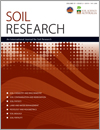The incidence of drought is predicted to increase, therefore a review of the fundamental processes related to the effects of drought on pasture, soil, and soil microorganisms in grassland systems is essential. Drought induces significant changes to the plant–soil system affecting the flows and cycling of nutrients, but strategies may be implemented to promote more drought-resilient grasslands.

Soil Research
Volume 57 Number 2 2019
SR18246A meta-analysis of exchangeable aluminium in New Zealand soils using the National Soils Database
Soil acidification and associated Al toxicity are becoming critical issues in New Zealand. There is a need to understand which soils and areas may be more susceptible to high concentrations of exchangeable Al that could be toxic to plants. This study has identified variables that are important for explaining the spatial variability of soil exchangeable Al concentrations and the relationships between those variables and Al in three depth zones in the soil profile using the New Zealand National Soils Database.
This study compared the effects of conventional and organic crop production systems on the quality and quantity of soil organic matter, which are the key factors determining soil properties and microbial activity and diversity. The organic system favoured protection of soil fertility and quality as the main basis for crop production, and is therefore recommended.
SR18113 Abstract | SR18113 Full Text | SR18113PDF (727 KB) Open Access Article
Microbial pathogens in farm dairy effluent can leach through soils into water bodies and cause disease in humans and livestock. A map showing the potential risk of a microbial tracer Escherichia coli to leach through soils within the Waikato River catchment has been developed based on laboratory and field studies. Approximately 60% of soils in the Waikato River catchment have a low potential to leach E. coli.
SR18068Responses of soil organic carbon, aggregate stability, carbon and nitrogen fractions to 15 and 24 years of no-till diversified crop rotations
 and Shannon Osborne
and Shannon Osborne
We conducted a long-term study to examine the effects of crop rotation on soil properties in different soil types under no-till systems. We found that adding more crops in rotation sustain soil quality by enhancing soil carbon and nitrogen content, making them a keystone for sustainable agroecosystems.
SR18159Suppressiveness or conduciveness to Fusarium wilt of bananas differs between key Australian soils
Fusarium wilt of bananas, or Panama disease, threatens banana production globally, and a virulent form of the pathogen has recently been detected in Queensland, Australia. This work showed that severity of Panama disease differs between key soils used to grow bananas in Queensland. The results will be useful for minimising impacts of the disease, if it is to spread beyond quarantine measures, and there is not yet a resistant and commercially acceptable banana cultivar.
We investigated whether stable isotope profiles varied between mound and depression of gilgaied Vertosol in a brigalow/belah forest. Despite the potential for differences in infiltration between mounds and depressions, there was little difference in isotope profiles with the exception of the upper 30cm. This suggests that either gilgai component may be sampled for ecohydrological studies.
Trace and heavy metal elements in soil pose a significant threat to human health. This case study shows the decadal change and ecological risk of soil trace and heavy metal elements in a desert oasis. The results suggested that potential health risks are likely to increase in the area, and crop intercropping with alfalfa is a useful way to weaken this increasing trend.
SR18145Conservation agriculture effects on soil properties and crop productivity in a semiarid region of India
 , M. Salikram, N. K. Sinha, M. Mohanty, R. S. Chaudhary, R. C. Dalal
, M. Salikram, N. K. Sinha, M. Mohanty, R. S. Chaudhary, R. C. Dalal  , N. G. Mitra, D. Blaise, M. V. Coumar, K. M. Hati, J. K. Thakur, S. Neenu, A. K. Biswas, A. K. Patra and S. K. Chaudhari
, N. G. Mitra, D. Blaise, M. V. Coumar, K. M. Hati, J. K. Thakur, S. Neenu, A. K. Biswas, A. K. Patra and S. K. Chaudhari
Conservation agriculture (CA) including reduced or no-tillage and crop residue retention, is known to be a self-sustainable system and an alternative to residue burning. The CA approach not only enhances soil health but also conserves soil, water and energy by increasing soil organic carbon and soil aggregation. Thus, CA could be a sustainable management practice for improving soil health and crop yields.



